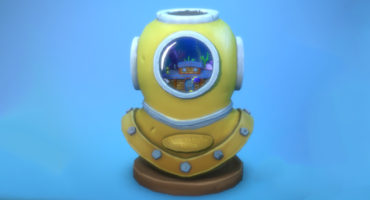In Art Spotlight, we invite Sketchfab artists to talk about one of their designs.
About Me
Hi! I’m Mickael, a digital artist who practice 3D, animation, videos, design and programming. Holder of a Bachelor of Arts (digital arts), I’m still studying at an university of arts (Arts²), for my Masters degree. I used to learn by myself by watching tutorials or trying something new, figure out how it works, and of course by making mistakes. That’s really the main way to learn, via mistakes.
I use 3D and video softwares since I was 11 years old, and I slowly began to create my own artistic identity. I take pleasure in creating things, whether are websites, drawings, videos, programming or 3D, but the last one is definitely the most interesting to me.
The Steps
The first thing before modeling or even opening the 3D software is searching for reference pictures, like photographs of action figure, toys, posters, screenshots from trailer and from the movie itself (spoiler alert? Actually, not really).
For the differents steps, I’ve recorded 4 sped-up videos, showing the modeling and texturing process. Here are the links:
Part 1 :
Part 2 :
Part 3 :
Part 4 :
Textures
I modeled K-2SO in “spare parts”, with one UV per part, then I gathered them to make a texture atlas (high resolution image regrouping all the UV in one). The UV were made in C4D, but I haven’t recorded that process, way too long.
On left, diffuse texture material + Ambient Occlusion
On right, UV mesh + Ambient Occlusion
Once the atlas is completed, I imported the model in Substance Painter, and started to paint it, add scratches, rust, different materials and layers of textures (this step is in the 4th speed up video).
Rig of the Model
The skeleton is based on a simple biped anatomy, but of course with the K-2SO proportions (long arms and legs). The way the bones are put together is very specific, because the model is a droid, with metallic limbs. So, it doesn’t allow any stretchiness or distortion with the mesh while moving. For the animation, I watched the movie again, and chose a scene with K-2SO (this moment is at 0:26:50 of the movie, if you want see).
Sketchfab Integration
When the animation was completed, I planned out how to show the model in Sketchfab. The first thing was to take the background behind K-2SO in the movie and add it in the 3D scene. There were no widescreen bands at this time, yet. Then, I remembered a very clever idea I’d seen some time ago, about matte painting and FX integration in old movies, like Charlie Chaplin. 
From that point, I made the little set, inspired by the film industry, like a blooper. I immediately thought that will be perfect for Sketchfab integration, because the user can move around and see the backstage. For that little animation project, Sketchfab was the perfect tool to make the interactivity possible.
Contact Info
Special thanks to the Sketchfab community!







